transmission fluid DODGE GRAND CARAVAN 2009 5.G Owners Manual
[x] Cancel search | Manufacturer: DODGE, Model Year: 2009, Model line: GRAND CARAVAN, Model: DODGE GRAND CARAVAN 2009 5.GPages: 535, PDF Size: 18.61 MB
Page 343 of 535
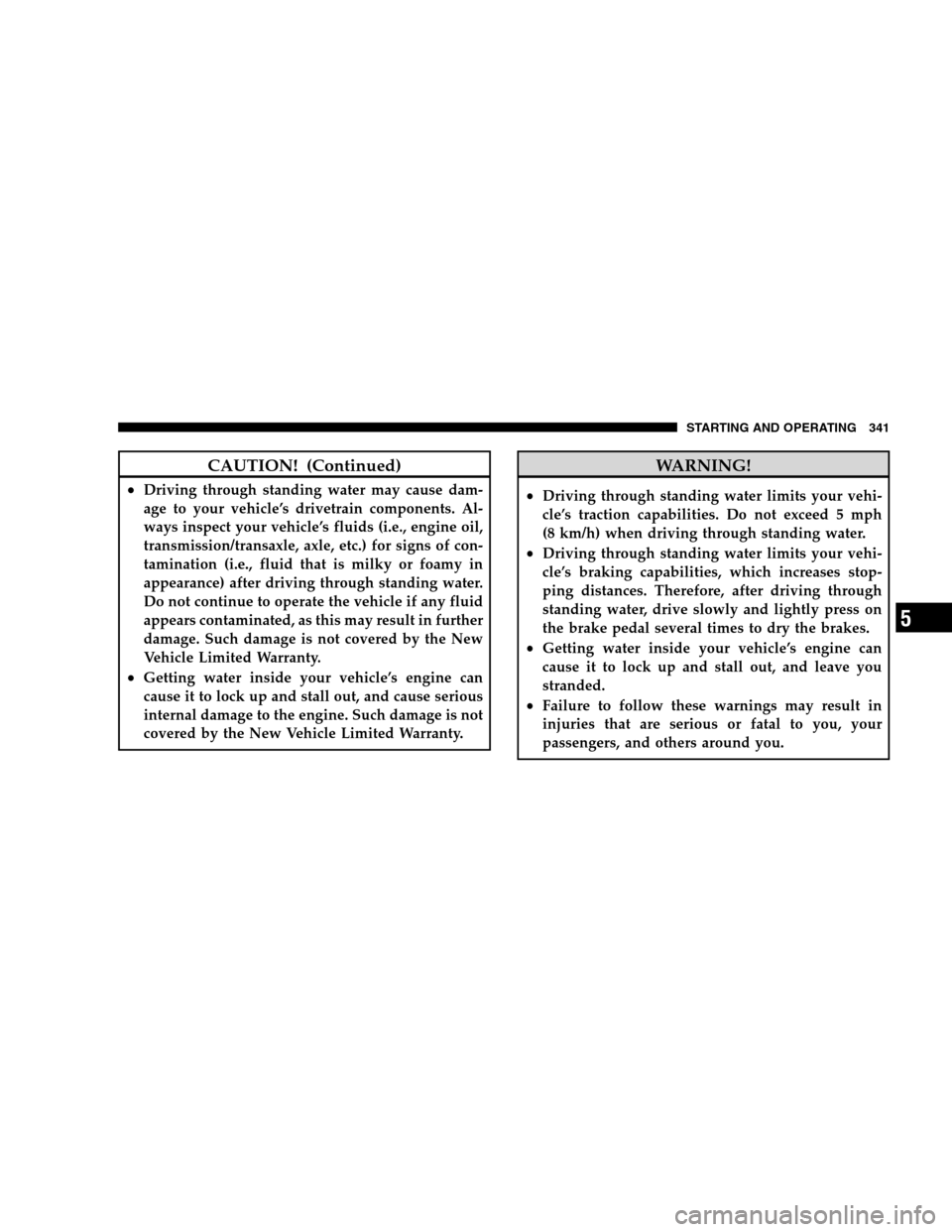
CAUTION! (Continued)
Driving through standing water may cause dam-
age to your vehicle’s drivetrain components. Al-
ways inspect your vehicle’s fluids (i.e., engine oil,
transmission/transaxle, axle, etc.) for signs of con-
tamination (i.e., fluid that is milky or foamy in
appearance) after driving through standing water.
Do not continue to operate the vehicle if any fluid
appears contaminated, as this may result in further
damage. Such damage is not covered by the New
Vehicle Limited Warranty.
Getting water inside your vehicle’s engine can
cause it to lock up and stall out, and cause serious
internal damage to the engine. Such damage is not
covered by the New Vehicle Limited Warranty. WARNING!
Driving through standing water limits your vehi-
cle’s traction capabilities. Do not exceed 5 mph
(8 km/h) when driving through standing water.
Driving through standing water limits your vehi-
cle’s braking capabilities, which increases stop-
ping distances. Therefore, after driving through
standing water, drive slowly and lightly press on
the brake pedal several times to dry the brakes.
Getting water inside your vehicle’s engine can
cause it to lock up and stall out, and leave you
stranded.
Failure to follow these warnings may result in
injuries that are serious or fatal to you, your
passengers, and others around you.
STARTING AND OPERATING 341 5
Page 426 of 535
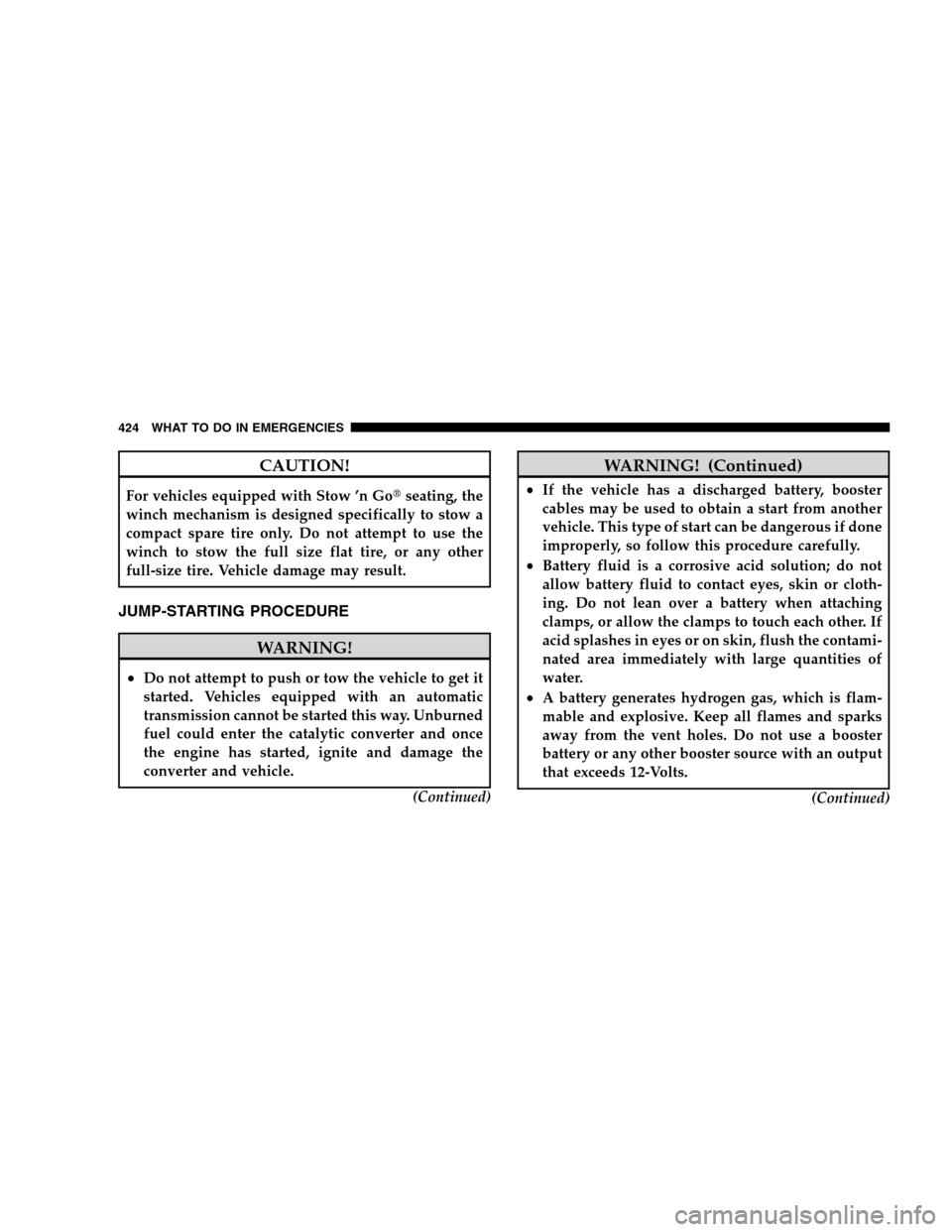
CAUTION!For vehicles equipped with Stow ’n Got
seating, the
winch mechanism is designed specifically to stow a
compact spare tire only. Do not attempt to use the
winch to stow the full size flat tire, or any other
full-size tire. Vehicle damage may result.
JUMP-STARTING PROCEDURE WARNING!
Do not attempt to push or tow the vehicle to get it
started. Vehicles equipped with an automatic
transmission cannot be started this way. Unburned
fuel could enter the catalytic converter and once
the engine has started, ignite and damage the
converter and vehicle.
(Continued) WARNING! (Continued)
If the vehicle has a discharged battery, booster
cables may be used to obtain a start from another
vehicle. This type of start can be dangerous if done
improperly, so follow this procedure carefully.
Battery fluid is a corrosive acid solution; do not
allow battery fluid to contact eyes, skin or cloth-
ing. Do not lean over a battery when attaching
clamps, or allow the clamps to touch each other. If
acid splashes in eyes or on skin, flush the contami-
nated area immediately with large quantities of
water.
A battery generates hydrogen gas, which is flam-
mable and explosive. Keep all flames and sparks
away from the vent holes. Do not use a booster
battery or any other booster source with an output
that exceeds 12-Volts.
(Continued)
424 WHAT TO DO IN EMERGENCIES
Page 435 of 535
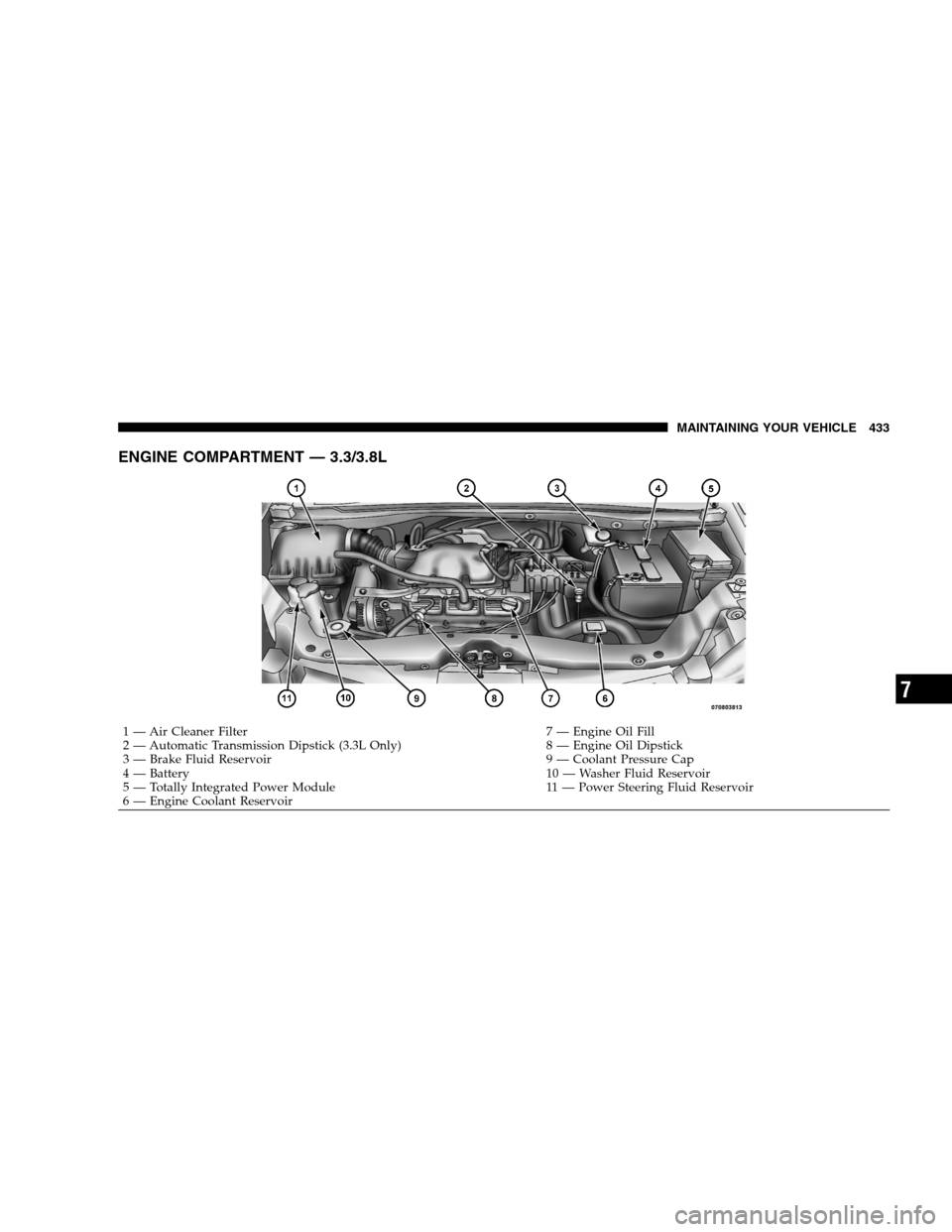
ENGINE COMPARTMENT — 3.3/3.8L
1 — Air Cleaner Filter
7 — Engine Oil Fill
2 — Automatic Transmission Dipstick (3.3L Only) 8 — Engine Oil Dipstick
3 — Brake Fluid Reservoir 9 — Coolant Pressure Cap
4 — Battery 10 — Washer Fluid Reservoir
5 — Totally Integrated Power Module 11 — Power Steering Fluid Reservoir
6 — Engine Coolant Reservoir MAINTAINING YOUR VEHICLE 433 7
Page 441 of 535
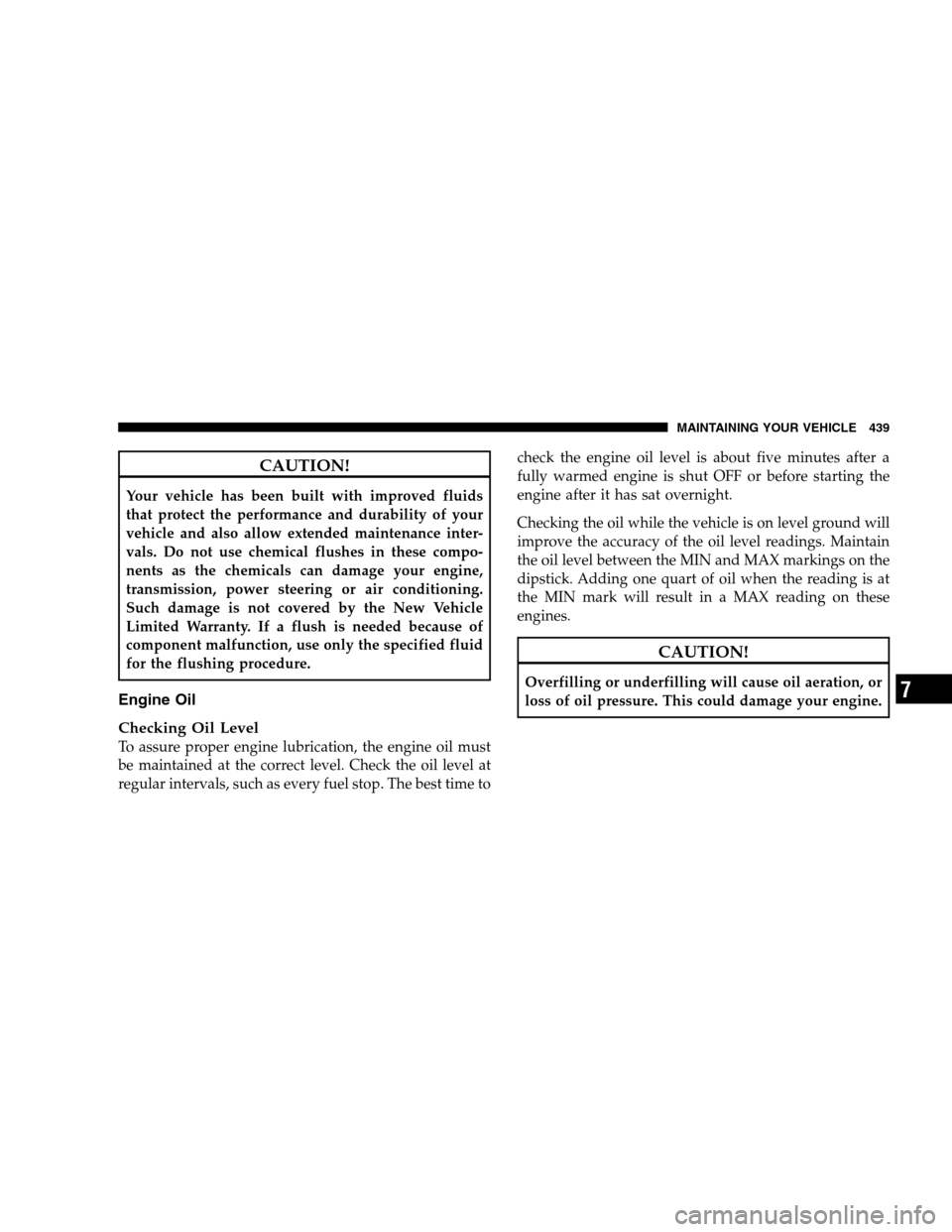
CAUTION!Your vehicle has been built with improved fluids
that protect the performance and durability of your
vehicle and also allow extended maintenance inter-
vals. Do not use chemical flushes in these compo-
nents as the chemicals can damage your engine,
transmission, power steering or air conditioning.
Such damage is not covered by the New Vehicle
Limited Warranty. If a flush is needed because of
component malfunction, use only the specified fluid
for the flushing procedure.
Engine Oil
Checking Oil Level
To assure proper engine lubrication, the engine oil must
be maintained at the correct level. Check the oil level at
regular intervals, such as every fuel stop. The best time to
check the engine oil level is about five minutes after a
fully warmed engine is shut OFF or before starting the
engine after it has sat overnight.
Checking the oil while the vehicle is on level ground will
improve the accuracy of the oil level readings. Maintain
the oil level between the MIN and MAX markings on the
dipstick. Adding one quart of oil when the reading is at
the MIN mark will result in a MAX reading on these
engines. CAUTION!
Overfilling or underfilling will cause oil aeration, or
loss of oil pressure. This could damage your engine.
MAINTAINING YOUR VEHICLE 439
7
Page 460 of 535
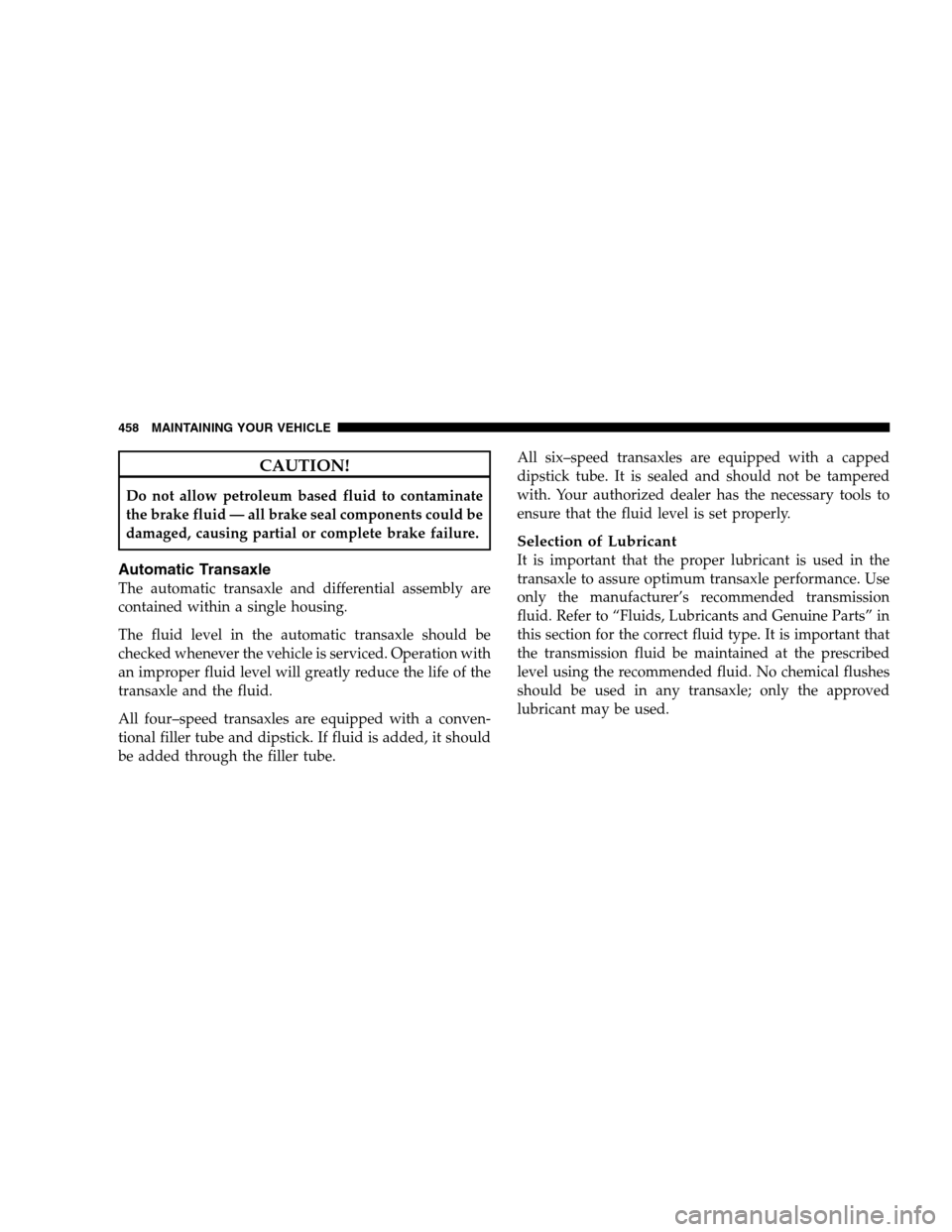
CAUTION!Do not allow petroleum based fluid to contaminate
the brake fluid — all brake seal components could be
damaged, causing partial or complete brake failure.
Automatic Transaxle
The automatic transaxle and differential assembly are
contained within a single housing.
The fluid level in the automatic transaxle should be
checked whenever the vehicle is serviced. Operation with
an improper fluid level will greatly reduce the life of the
transaxle and the fluid.
All four–speed transaxles are equipped with a conven-
tional filler tube and dipstick. If fluid is added, it should
be added through the filler tube.
All six–speed transaxles are equipped with a capped
dipstick tube. It is sealed and should not be tampered
with. Your authorized dealer has the necessary tools to
ensure that the fluid level is set properly.
Selection of Lubricant
It is important that the proper lubricant is used in the
transaxle to assure optimum transaxle performance. Use
only the manufacturer’s recommended transmission
fluid. Refer to “Fluids, Lubricants and Genuine Parts” in
this section for the correct fluid type. It is important that
the transmission fluid be maintained at the prescribed
level using the recommended fluid. No chemical flushes
should be used in any transaxle; only the approved
lubricant may be used.
458 MAINTAINING YOUR VEHICLE
Page 461 of 535
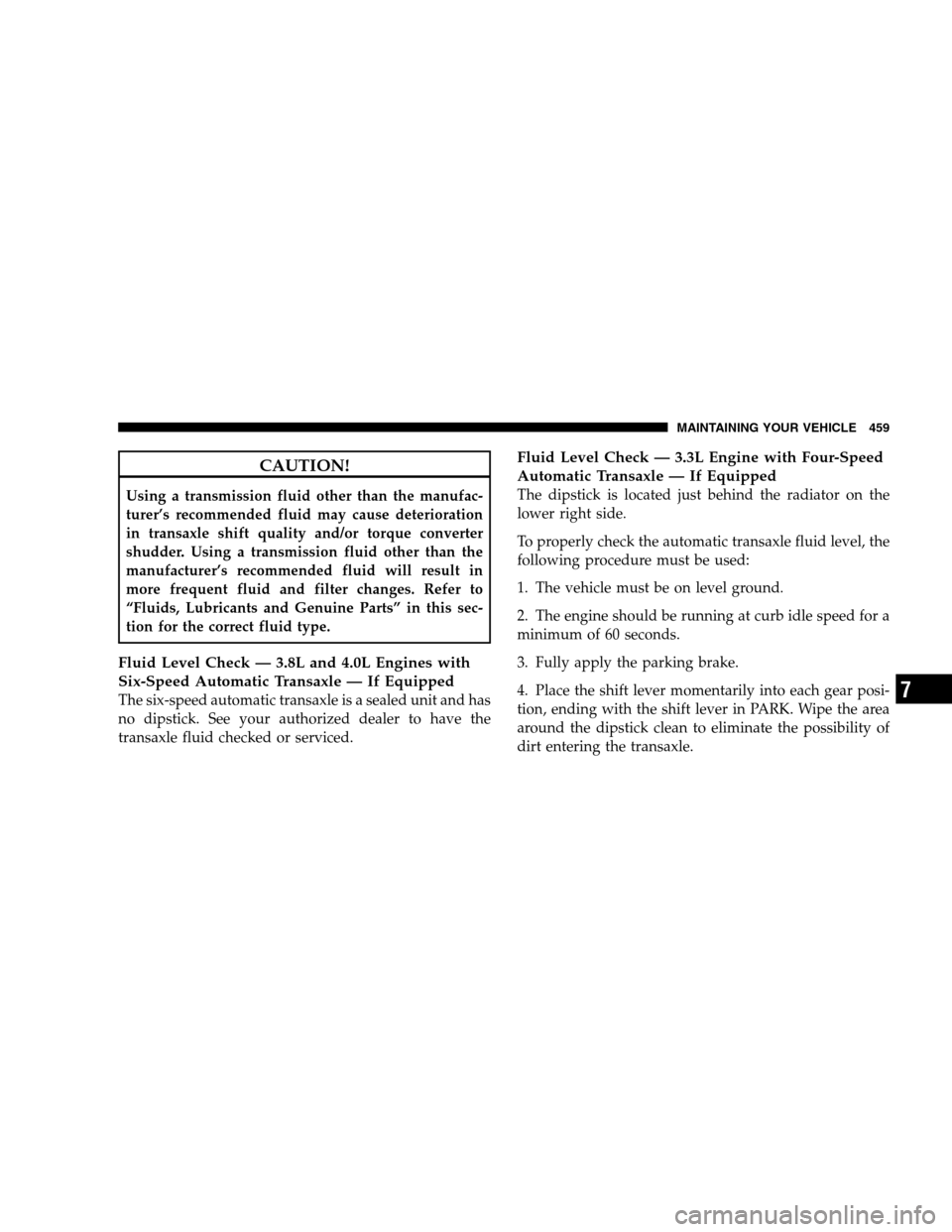
CAUTION!Using a transmission fluid other than the manufac-
turer’s recommended fluid may cause deterioration
in transaxle shift quality and/or torque converter
shudder. Using a transmission fluid other than the
manufacturer’s recommended fluid will result in
more frequent fluid and filter changes. Refer to
“Fluids, Lubricants and Genuine Parts” in this sec-
tion for the correct fluid type.
Fluid Level Check — 3.8L and 4.0L Engines with
Six-Speed Automatic Transaxle — If Equipped
The six-speed automatic transaxle is a sealed unit and has
no dipstick. See your authorized dealer to have the
transaxle fluid checked or serviced.
Fluid Level Check — 3.3L Engine with Four-Speed
Automatic Transaxle — If Equipped
The dipstick is located just behind the radiator on the
lower right side.
To properly check the automatic transaxle fluid level, the
following procedure must be used:
1. The vehicle must be on level ground.
2. The engine should be running at curb idle speed for a
minimum of 60 seconds.
3. Fully apply the parking brake.
4. Place the shift lever momentarily into each gear posi-
tion, ending with the shift lever in PARK. Wipe the area
around the dipstick clean to eliminate the possibility of
dirt entering the transaxle.
MAINTAINING YOUR VEHICLE 459
7
Page 462 of 535
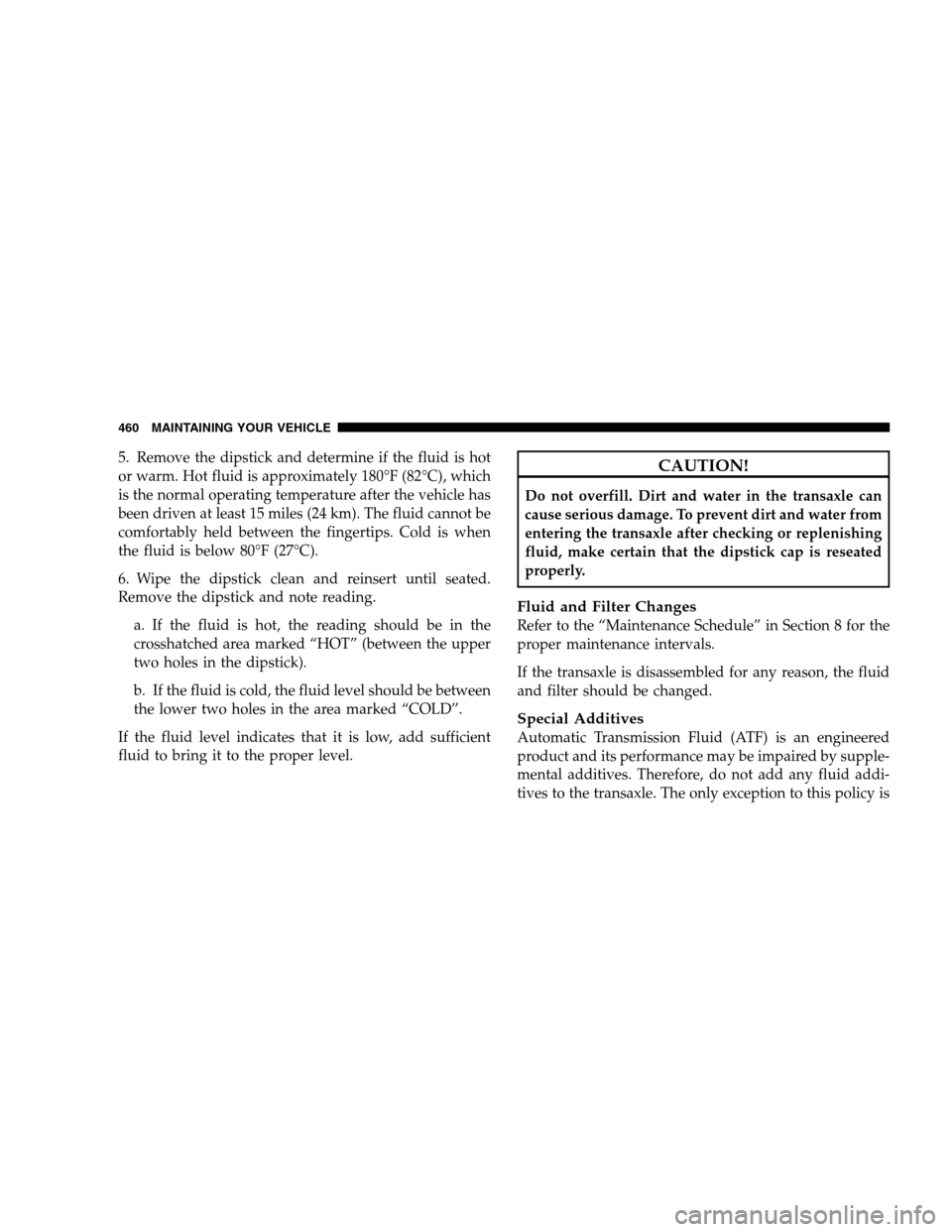
5. Remove the dipstick and determine if the fluid is hot
or warm. Hot fluid is approximately 180°F (82°C), which
is the normal operating temperature after the vehicle has
been driven at least 15 miles (24 km). The fluid cannot be
comfortably held between the fingertips. Cold is when
the fluid is below 80°F (27°C).
6. Wipe the dipstick clean and reinsert until seated.
Remove the dipstick and note reading.a. If the fluid is hot, the reading should be in the
crosshatched area marked “HOT” (between the upper
two holes in the dipstick).
b. If the fluid is cold, the fluid level should be between
the lower two holes in the area marked “COLD”.
If the fluid level indicates that it is low, add sufficient
fluid to bring it to the proper level. CAUTION!
Do not overfill. Dirt and water in the transaxle can
cause serious damage. To prevent dirt and water from
entering the transaxle after checking or replenishing
fluid, make certain that the dipstick cap is reseated
properly.
Fluid and Filter Changes
Refer to the “Maintenance Schedule” in Section 8 for the
proper maintenance intervals.
If the transaxle is disassembled for any reason, the fluid
and filter should be changed.
Special Additives
Automatic Transmission Fluid (ATF) is an engineered
product and its performance may be impaired by supple-
mental additives. Therefore, do not add any fluid addi-
tives to the transaxle. The only exception to this policy is
460 MAINTAINING YOUR VEHICLE
Page 463 of 535

the use of special dyes to aid in detecting fluid leaks. In
addition, avoid using transaxle sealers as they may
adversely affect seals.CAUTION!
Do not use chemical flushes in your transmission as
the chemicals can damage your transmission compo-
nents. Such damage is not covered by the New
Vehicle Limited Warranty.
Appearance Care and Protection from Corrosion
Protection of Body and Paint from Corrosion
Vehicle body care requirements vary according to geo-
graphic locations and usage. Chemicals that make roads
passable in snow and ice, and those that are sprayed on
trees and road surfaces during other seasons, are highly
corrosive to the metal in your vehicle. Outside parking,
which exposes your vehicle to airborne contaminants,
road surfaces on which the vehicle is operated, extreme
hot or cold weather and other extreme conditions will
have an adverse effect on paint, metal trim, and under-
body protection.
The following maintenance recommendations will enable
you to obtain maximum benefit from the corrosion
resistance built into your vehicle.
What Causes Corrosion?
Corrosion is the result of deterioration or removal of
paint and protective coatings from your vehicle.
The most common causes are:
Road salt, dirt and moisture accumulation
Stone and gravel impact
Insects, tree sap and tar
Salt in the air near seacoast localities
Atmospheric fallout/industrial pollutants
MAINTAINING YOUR VEHICLE 461 7
Page 484 of 535
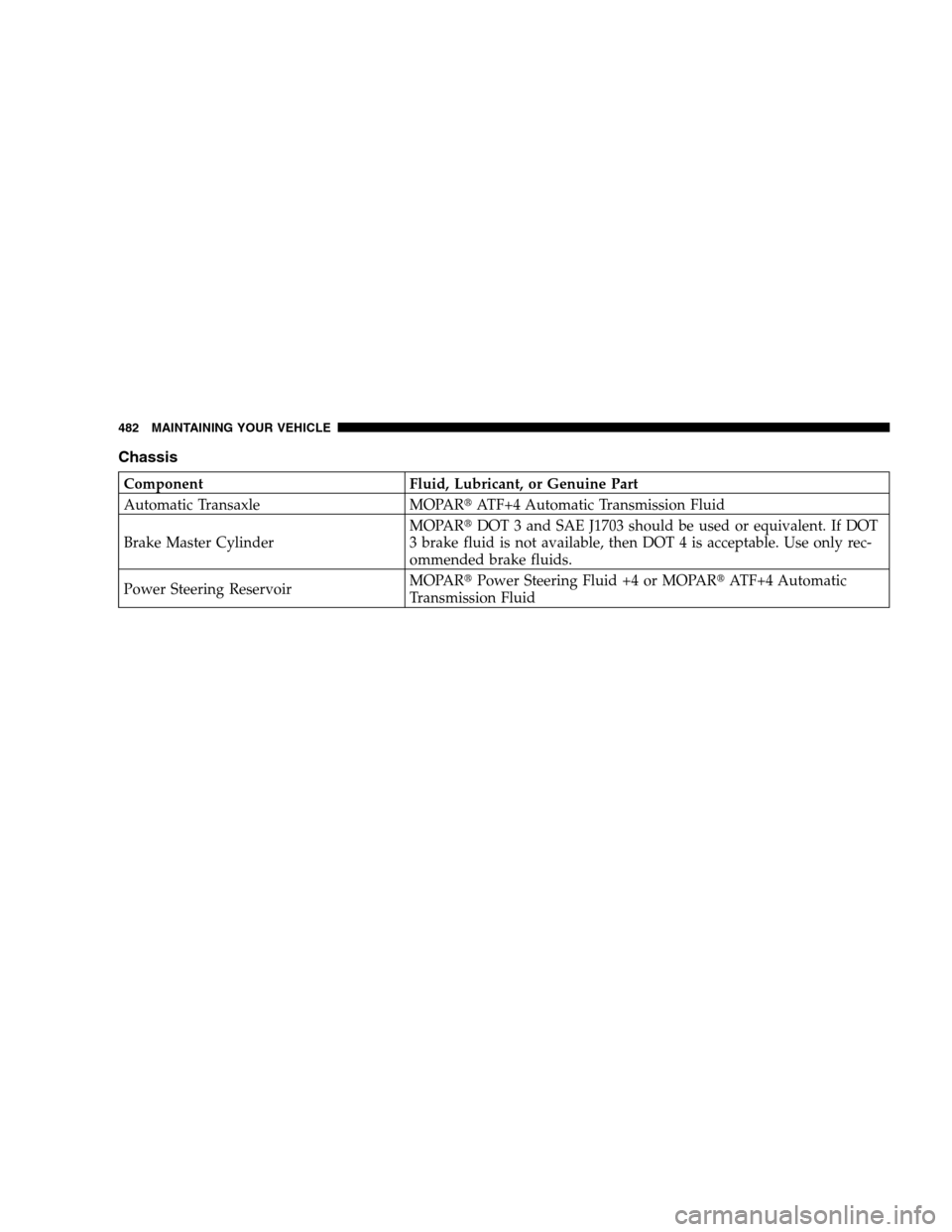
ChassisComponent
Fluid, Lubricant, or Genuine Part
Automatic Transaxle MOPARtATF+4 Automatic Transmission Fluid
Brake Master Cylinder MOPARt
DOT 3 and SAE J1703 should be used or equivalent. If DOT
3 brake fluid is not available, then DOT 4 is acceptable. Use only rec-
ommended brake fluids.
Power Steering Reservoir MOPARt
Power Steering Fluid +4 or MOPARt ATF+4 Automatic
Transmission Fluid
482 MAINTAINING YOUR VEHICLE
Page 515 of 535
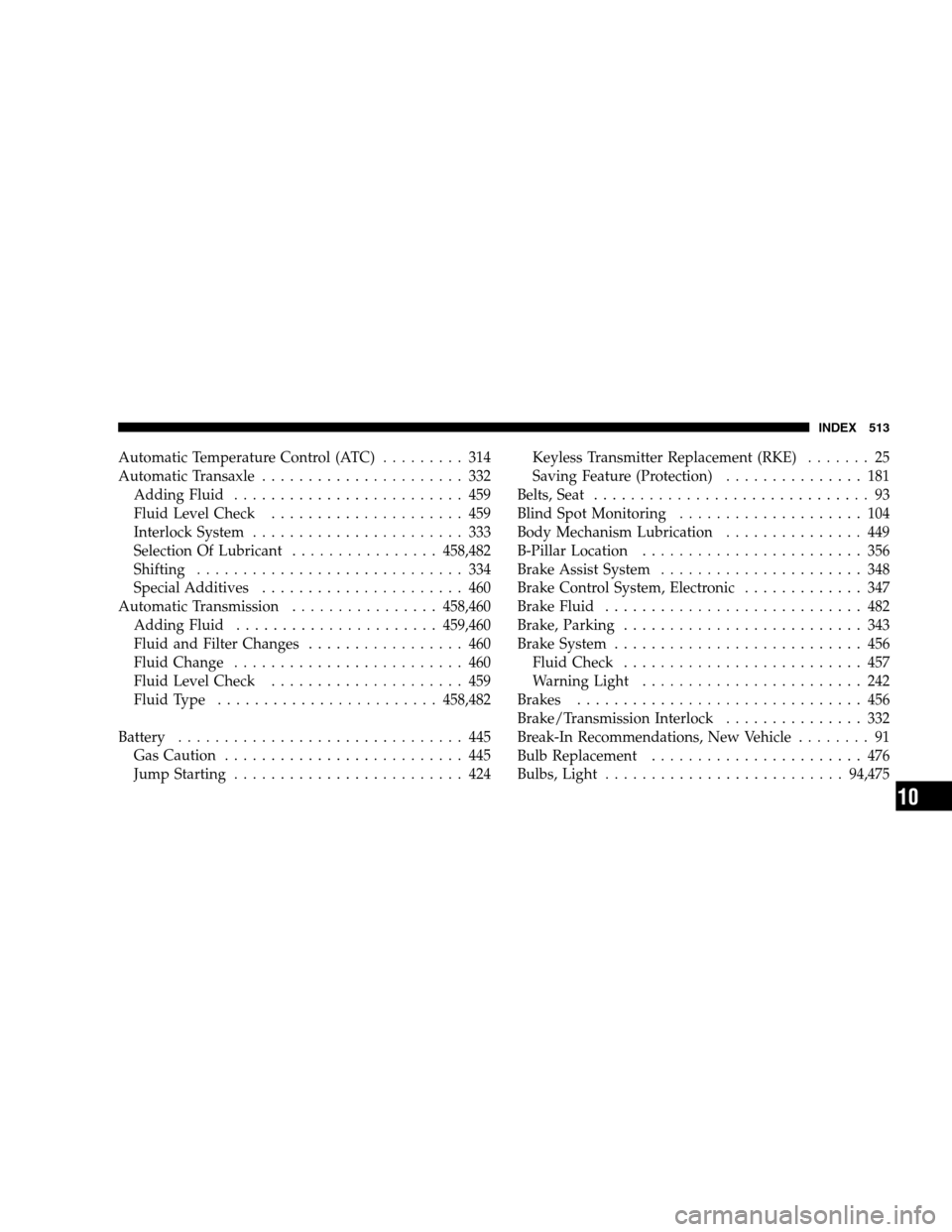
Automatic Temperature Control (ATC) . . . . . . . . . 314
Automatic Transaxle . . . . . . . . . . . . . . . . . . . . . . 332Adding Fluid . . . . . . . . . . . . . . . . . . . . . . . . . 459
Fluid Level Check . . . . . . . . . . . . . . . . . . . . . 459
Interlock System . . . . . . . . . . . . . . . . . . . . . . . 333
Selection Of Lubricant . . . . . . . . . . . . . . . . 458,482
Shifting . . . . . . . . . . . . . . . . . . . . . . . . . . . . . 334
Special Additives . . . . . . . . . . . . . . . . . . . . . . 460
Automatic Transmission . . . . . . . . . . . . . . . . 458,460 Adding Fluid . . . . . . . . . . . . . . . . . . . . . . 459,460
Fluid and Filter Changes . . . . . . . . . . . . . . . . . 460
Fluid Change . . . . . . . . . . . . . . . . . . . . . . . . . 460
Fluid Level Check . . . . . . . . . . . . . . . . . . . . . 459
Fluid Type . . . . . . . . . . . . . . . . . . . . . . . . 458,482
Battery . . . . . . . . . . . . . . . . . . . . . . . . . . . . . . . 445 Gas Caution . . . . . . . . . . . . . . . . . . . . . . . . . . 445
Jump Starting . . . . . . . . . . . . . . . . . . . . . . . . . 424 Keyless Transmitter Replacement (RKE) . . . . . . . 25
Saving Feature (Protection) . . . . . . . . . . . . . . . 181
Belts, Seat . . . . . . . . . . . . . . . . . . . . . . . . . . . . . . 93
Blind Spot Monitoring . . . . . . . . . . . . . . . . . . . . 104
Body Mechanism Lubrication . . . . . . . . . . . . . . . 449
B-Pillar Location . . . . . . . . . . . . . . . . . . . . . . . . 356
Brake Assist System . . . . . . . . . . . . . . . . . . . . . . 348
Brake Control System, Electronic . . . . . . . . . . . . . 347
Brake Fluid . . . . . . . . . . . . . . . . . . . . . . . . . . . . 482
Brake, Parking . . . . . . . . . . . . . . . . . . . . . . . . . . 343
Brake System . . . . . . . . . . . . . . . . . . . . . . . . . . . 456 Fluid Check . . . . . . . . . . . . . . . . . . . . . . . . . . 457
Warning Light . . . . . . . . . . . . . . . . . . . . . . . . 242
Brakes . . . . . . . . . . . . . . . . . . . . . . . . . . . . . . . 456
Brake/Transmission Interlock . . . . . . . . . . . . . . . 332
Break-In Recommendations, New Vehicle . . . . . . . . 91
Bulb Replacement . . . . . . . . . . . . . . . . . . . . . . . 476
Bulbs, Light . . . . . . . . . . . . . . . . . . . . . . . . . . 94,475
INDEX 513
10